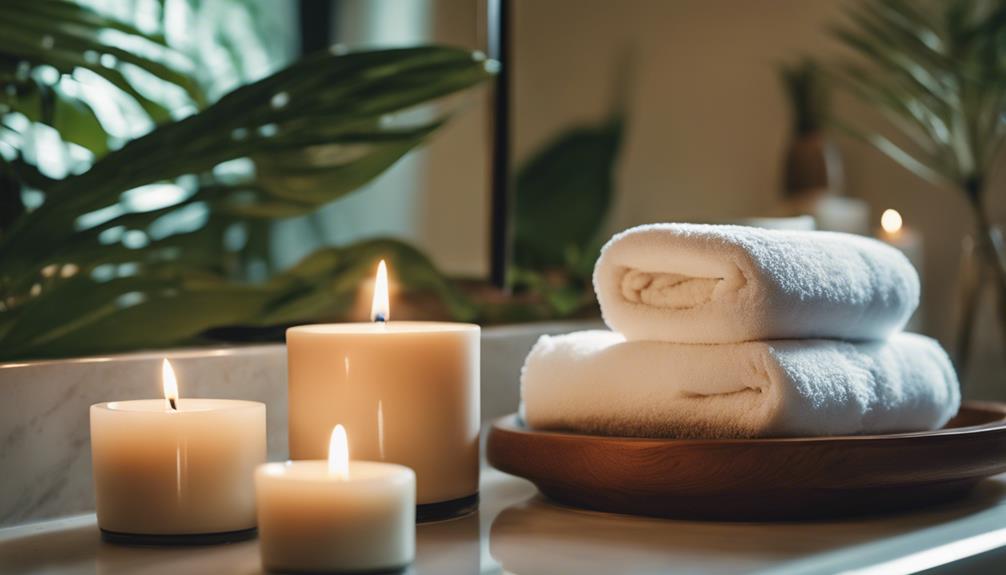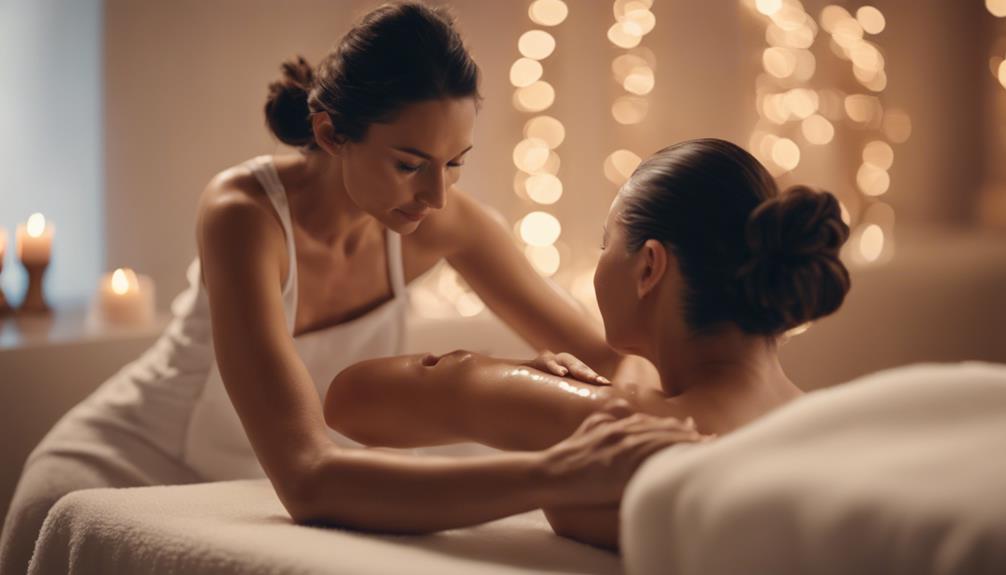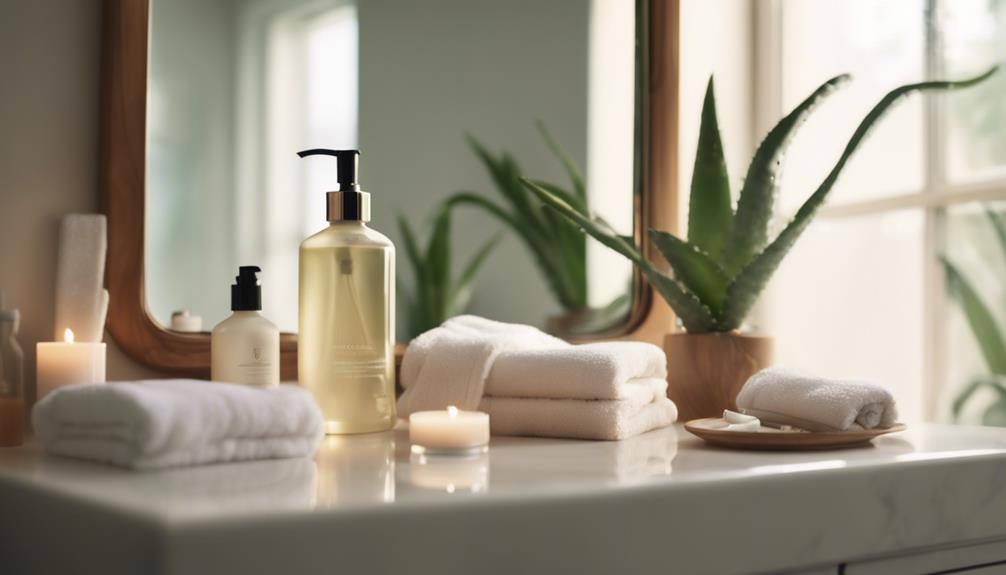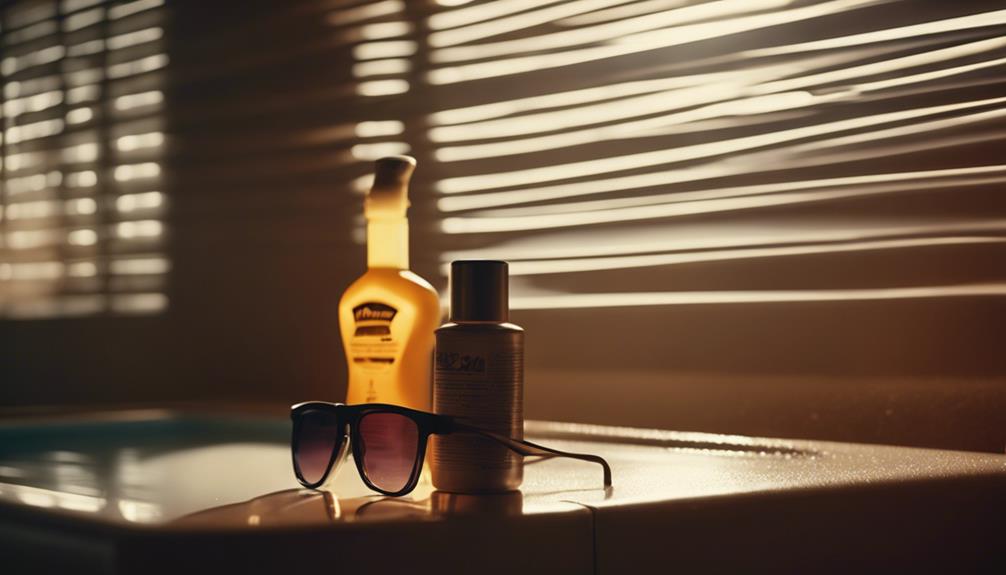To prevent tanning bed peeling, focus on three key areas: preparation, tanning technique, and aftercare. Start with a cool shower and gently exfoliate your skin. Apply a heavy moisturizer to keep your skin hydrated. When tanning, begin with short sessions and gradually increase the duration while avoiding peak sun hours. After tanning, use an aloe vera-based moisturizer to soothe and hydrate your skin. Remember to apply sunscreen daily and drink plenty of water to maintain moisture levels. Following these expert secrets will help keep your skin healthy and minimize peeling. There's much more to discover for ideal tanning care.
Key Takeaways
- Prepare your skin with a cool shower and gentle exfoliation to remove dead skin cells before tanning.
- Apply a generous layer of moisturizer before and after tanning to maintain hydration and skin elasticity.
- Gradually increase tanning duration and monitor skin reactions to prevent overexposure and peeling.
- Stay hydrated by drinking at least eight glasses of water daily to support skin health and resilience.
Skin Preparation Tips
To prevent tanning bed peeling, start by preparing your skin with a cool shower to gently exfoliate and remove dead skin without harsh scrubbing.
After your shower, apply a generous amount of moisturizer to lock in hydration.
Don't forget to use sunscreen with at least SPF 30 to protect your skin from harmful UV rays.
Wearing protective clothing, like a wide-brimmed hat or long sleeves, can also shield your skin from sun exposure.
Staying hydrated is essential, so drink at least eight glasses of water daily.
Finally, pay attention to your skin's condition; if it feels dry or irritated, adjust your routine to avoid peeling after tanning.
Following these steps will help guarantee a smoother tanning experience.
Effective Tanning Techniques
Gradually increasing your tanning duration allows your skin to adjust to UV exposure and minimizes the risk of peeling. Start with short sessions and pay attention to how your skin reacts. Avoid tanning during peak hours and opt for early morning or late afternoon. Always monitor the UV index to guarantee safety.
| Tanning Tips | Benefits |
|---|---|
| Short initial sessions | Reduces risk of burning |
| Tanning during off-peak | Less intense UV exposure |
| Gradual duration increase | Skin adapts better |
| Regular monitoring | Prevents overexposure |
Essential Post-Tan Care

Post-tan care is essential for maintaining your skin's health and preventing peeling. Start by using an aloe vera-based moisturizer to soothe and heal your skin after tanning.
Opt for cool showers to avoid stripping oils and causing dryness, which can lead to peeling. Regularly assess your skin condition and adjust your moisturizing routine as needed.
Remember to apply sunscreen with at least SPF 30 daily to protect your tan and keep your skin healthy. Hydration is key, so drink plenty of water to support your skin from within.
Nutritional Support for Skin
Nutritional support plays an essential role in maintaining skin health and preventing issues like peeling after tanning. By focusing on a balanced diet, you can enhance your skin's resilience.
Here are four key components to incorporate:
- Antioxidant-rich foods: Load up on fruits and vegetables, especially berries and citrus, to combat UV damage.
- Healthy fats: Include omega-3 sources like salmon, walnuts, and flaxseed to promote skin elasticity.
- Hydration: Drink at least eight glasses of water daily to keep your skin supple and nourished.
- Collagen boosters: Consume foods high in Vitamin C, which supports collagen production for firmer skin.
Hydration Strategies

Stay hydrated by drinking at least eight glasses of water daily to keep your skin looking healthy and prevent peeling after tanning.
When your skin is well-hydrated, it retains elasticity and reduces the likelihood of dryness and flaking.
Incorporate hydrating foods like cucumbers and oranges into your meals, as they're rich in water content.
Additionally, consider using a humidifier in your home to maintain moisture levels in the air, especially during dry seasons.
After tanning, apply a hydrating moisturizer immediately to lock in moisture.
Remember to avoid excessive hot showers, as they can strip your skin of its natural oils.
Identifying Skin Damage
Recognizing the signs of skin damage is essential, especially after tanning, as it can help you take immediate action to protect your skin's health.
Pay close attention to changes in your skin's appearance and feel. Here are some key indicators of potential damage:
- Redness or Inflammation: Any significant discoloration can signal irritation or sunburn.
- Blisters: These are serious signs of skin damage that require prompt attention.
- Excessive Peeling: If your skin begins to shed more than usual, it may indicate overexposure.
- Persistent Pain: If you experience ongoing discomfort, it might be time to consult a professional.
Professional Help and Advice

When you notice signs of skin damage after tanning, seeking professional help can guarantee your skin receives the appropriate care it needs.
Dermatologists can assess the extent of the damage and recommend treatments tailored to your situation. If you're experiencing severe burns, persistent pain, or blisters, don't hesitate to contact a specialist immediately.
They might prescribe soothing creams or suggest specific moisturizers to aid recovery. Regular check-ups can also help you monitor your skin's condition over time, ensuring you catch any issues early.
Frequently Asked Questions
Can I Use Self-Tanner Instead of a Tanning Bed?
Absolutely, you can use self-tanner instead of a tanning bed. Self-tanners allow you to achieve a sun-kissed glow without harmful UV exposure, reducing the risk of skin damage while giving you a natural-looking tan.
How Often Should I Moisturize Before Tanning?
You should moisturize daily, especially in the days leading up to tanning. Apply a good moisturizer twice a day to keep your skin hydrated and supple, which helps achieve an even, long-lasting tan.
What Are the Best Bronzers for Sensitive Skin?
Choosing bronzers for sensitive skin is like selecting a gentle hug; look for lightweight, hypoallergenic formulas free from harsh chemicals. Brands with natural ingredients can enhance your glow while soothing and protecting your delicate complexion.
Is It Safe to Tan With a Spray Tan?
Yes, it's safe to tan with a spray tan. Just make sure you follow the application instructions carefully, avoid excessive sun exposure right after, and always use a good moisturizer to maintain your glow.
How Long Should I Wait Between Tanning Sessions?
Imagine your skin as a garden; you wouldn't water it every hour. Similarly, wait at least 48 hours between tanning sessions. This gives your skin time to rejuvenate and absorb the sun's warmth effectively.
Conclusion
By following these expert secrets, you can achieve that sun-kissed glow without the hassle of peeling skin.
Think of your skin as a canvas; with the right preparation and care, it'll be smooth and radiant, just like a masterpiece.
Keep your skin nourished and hydrated, and always listen to its needs.
With these tips in mind, you're ready to flaunt a beautiful tan that lasts, letting your confidence shine just as brightly as your skin!










